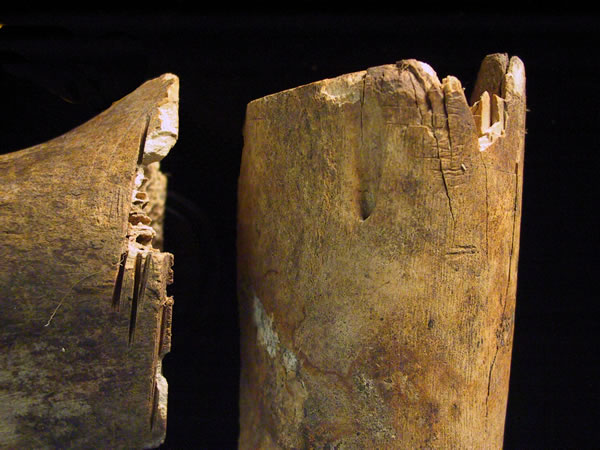August 21, 2002
In the last update I reported discovery of a large rectangular feature during machine stripping of topsoil. Much of our effort over the last several days has focused on this feature and some smaller ones nearby. There was much speculation initially about the age of this feature, as well as its original purpose—now we have some answers to those questions. This kind of sequence is typical of archaeological fieldwork; that is to say gradual refinement of working interpretations as more and more evidence is collected. And it is always a thrill to get to the bottom of a problem—literally—after painstaking work.
 Here's how we go about exploring the secrets of the large stain in the soil that we know as Feature 8. The main objective is to remove one half of the "fill" that was put back into the rectangular pit long ago. Doing so allows us to learn about the structure of the feature before the other half is removed, and to get a useful cross-section view of the sequence of filling. The cross section provides a mini-history of the feature itself. Using small hand tools the fill is excavated according to natural layers. These layers or strata within the feature are recognized by different colors and textures of soil, as well as by varying quantities and types of artifacts. As usual, artifacts not directly recovered by the excavators are collected as the fill soil is sifted. Detailed drawings and photographs are made as excavation progresses. In essence we keep good records because we want to “reconstruct” the feature again in the lab.
Here's how we go about exploring the secrets of the large stain in the soil that we know as Feature 8. The main objective is to remove one half of the "fill" that was put back into the rectangular pit long ago. Doing so allows us to learn about the structure of the feature before the other half is removed, and to get a useful cross-section view of the sequence of filling. The cross section provides a mini-history of the feature itself. Using small hand tools the fill is excavated according to natural layers. These layers or strata within the feature are recognized by different colors and textures of soil, as well as by varying quantities and types of artifacts. As usual, artifacts not directly recovered by the excavators are collected as the fill soil is sifted. Detailed drawings and photographs are made as excavation progresses. In essence we keep good records because we want to “reconstruct” the feature again in the lab.
Feature 8 has been determined to date from the period of Union occupation at City Point during the close of the Civil War. Although many artifacts in the upper fill were of earlier vintage—ceramics and pipes from the early 1800s, for instance—the most recent and most common ones date from the time of the war. The older items had simply been dumped into the pit as surrounding soil was used to backfill it. There was even a prehistoric spear point in the fill of this Civil War feature! The giveaway as to the military nature of the pit is two bullets in the lower fill. One bullet had been carved by a soldier as he whiled away time in camp. A bottle and large sections of ceramic containers are also typical of the war period. The most common artifact in the pit aside from nails is copious amounts of animal bone—those of cows, pigs, etc., and even a load of clamshells.
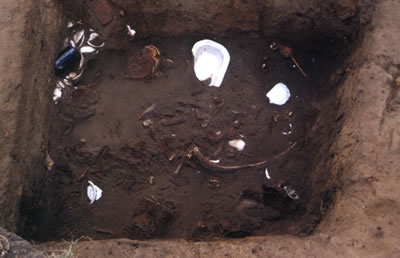 The present interpretation of the feature is that it was a below-ground storage area inside a winter shelter. When the shelter was abandoned, some items were left inside and other debris was dumped into the pit to fill it. The filling seems to have happened rapidly judging from the excellent preservation of the bone and the sequence of fill loads. Surrounding features represent postholes that may have supported the framework of the shelter.
The present interpretation of the feature is that it was a below-ground storage area inside a winter shelter. When the shelter was abandoned, some items were left inside and other debris was dumped into the pit to fill it. The filling seems to have happened rapidly judging from the excellent preservation of the bone and the sequence of fill loads. Surrounding features represent postholes that may have supported the framework of the shelter.
Feature 8 and the complex of features around it offer a wonderful opportunity to learn more about the day to day existence of the ordinary soldier in an extraordinary, sprawling military encampment. To our knowledge, no other features of this sort have been studied by archaeologists at City Point. We have exposed only a small portion of this property during our study, but the findings offer clear indications of outstanding opportunities to learn a great deal more.
The plan is to complete our work on this property today. We will work with city officials to devise a plan for additional fieldwork, perhaps on another property.
Artifacts
Even though Feature 8 dates to the Civil War, several artifacts from other periods were mixed into the soil when the pit was backfilled in the 1860s.
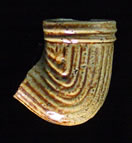
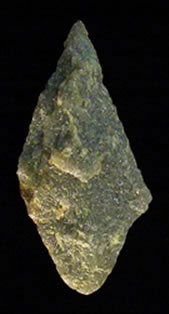
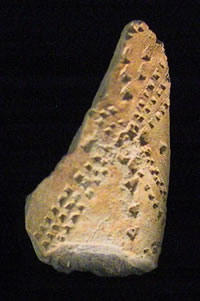
|
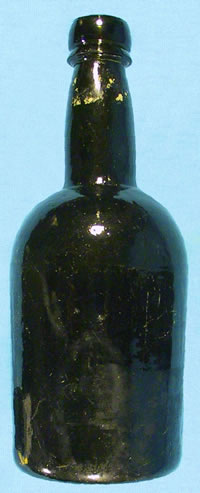
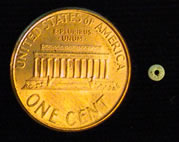
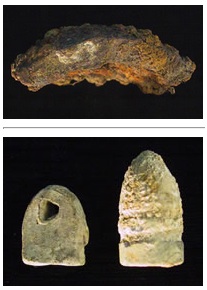
|
